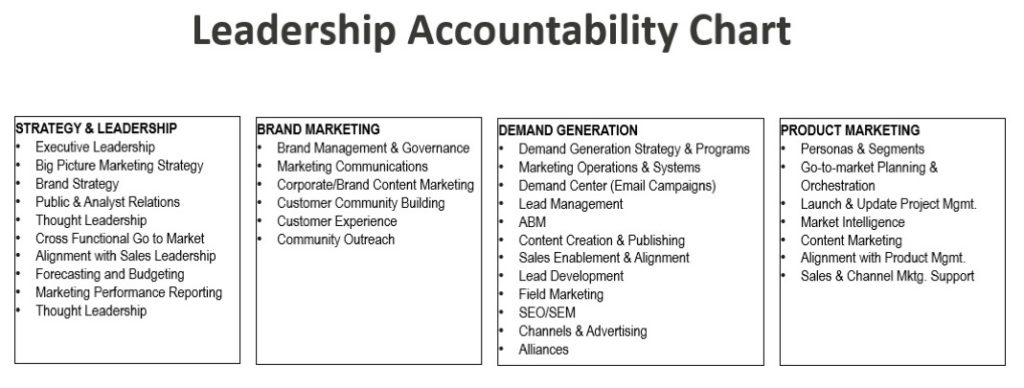
Great leaders credit success to their teams. That’s why you’ll often hear marketing leaders say things like, “I only want to hire rockstars.” The people component is critical when it comes to high-performance marketing because, when it comes down to it, the best team wins.
Over the past decade, the traditional model for structuring the marketing department has changed dramatically. Most senior marketing leaders who have either risen in the ranks or taken on a marketing team in a new organization are overseeing structures that are no longer relevant thanks to two major developments:
- The digital age: This new channel has required new resources and expertise, and we go to market differently as a result.
- The explosion of MarTech: The number of technology and tools available for marketing to adopt and use has grown exponentially.
I’m seeing better success in our mid-market and enterprise clients that have reshaped the structure of their marketing department to meet the changing marketing landscape head on, and I’d like to outline the structure and approach for you.
In fact, I recently had a great conversation with Engagio CMO Heidi Bullock (and former group VP of global marketing at Marketo) on how she’s building her own high-performance marketing team on a recent DemandGen Radio episode that I encourage you to listen to.
What a modern marketing organization looks like
First, throw out the standard organizational chart as a starting point. Why? Because focusing on your current reporting structure and team members puts the focus on the people instead of the roles and responsibilities you need.
I can’t stress this enough. If you truly want to build a modern marketing organization, you can’t start with who you already have and how they report to one another. It’s like trying to remodel your house using your existing materials and floor plan.
Several years ago, one of my mentors taught me about the concept of an accountability chart, which I brought to DemandGen. It’s almost like a mind map in that it’s a way to visually organize information — in this case, starting with your organization’s key functional areas and building out from there.
In most mid-market and enterprise organizations, there are four key functional areas within marketing:
- Strategy & Leadership
- Brand Marketing
- Demand Generation
- Product Marketing
Different organizations might refer to them differently (Marketing Communications or Corporate Marketing instead of Brand Marketing, for example), but you get the idea.

I suggest you take four pieces of legal size paper. Write down a header on each one and then add bullet points for the responsibilities in each functional area. Keep them high level for now.
Next, create smaller squares of paper for each of the responsibilities. Put these up on a white board, but don’t worry about who reports to who. Break that habit. All you’re focusing on doing is building an accountability chart for now.
Demand Generation might break into Field Marketing, Partner Marketing, Lead Development, Marketing Operations, and so on. The Marketing Operations responsibility might itself further break down into Marketing Technology, Website, Project Management, and Analytics.
By thinking about how to manage these big, core areas of responsibility, you move away from the people and the organizational chart and really focus on identifying the core areas and key functions.
Growing into a specialized approach
I’ve found that the four key functional areas above apply to any organization with more than 15 people in their marketing department, or 200 total employees. That’s when these functions really start to become less generalized and more specialized.
Smaller organizations and startups are not going to necessarily have this structure. A startup or small company may hire a jack of all trades who is responsible for demand generation programs as well as configuring and setting up marketing technology.
When resources and needs grow large enough to warrant a dedicated person or even an entire team supporting a single function, it’s time to throw out the org chart. And the larger an organization gets, the more built out the accountability chart is going to get.
Getting the right people in the right seats
Once all the key responsibilities have been identified, the next step is getting the right people in the right seats, because without that, this is all for naught. The approach I’m about to share was taught to me by my mentors and coaches, and it’s really well documented in Traction by Gino Wickman. He goes into more detail about the accountability chart in his book, as well as the concept of a GWC scorecard.
GWC poses the following questions:
- G: Does the person get it? Do they understand the role, responsibilities, culture, and pace and know what is expected of them?
- W: Do they want it? Are they passionate about the role? Would they enjoy that type of responsibility? You might understand something but not want to do it, and vice versa.
- C: Do they have the time and mental, physical, and emotional capacity to do the job well?
A “no” on any of these three means that this person is not the right fit for this particular seat.
For example, if a candidate scores G-yes, W-yes, but C-no, they don’t have the capacity for this particular role and are therefore not the right fit for this position. It’s great that they understand the role and actually want it, but it’s not enough.
Don’t forget that Capacity can also include time. Sometimes a position might require a commitment of 50 hours per week, but someone will only put in 40. Or, a person just might not have the intellectual capacity to do the role justice.
Start your journey toward a high-performance marketing team
I hope this inspires you to think about your own organization, and to get out the white board and map out those big functional areas for your team.
We’ve already helped several of our clients build a modern marketing organization. As consultants, we can help you build out your team in two ways:
- Identify and understand key functional areas and define roles and responsibilities in order to shape a custom accountability chart.
- Go through the GWC scorecard process for current team members and assist with networking when possible.
As I mentioned earlier, the best marketing wins. And the best marketing comes from having the right team doing the right things the right way. If you’re ready to introduce high-performance marketing to your organization, let us know how we can help!
 For more than 20 years, David Lewis has been a pioneering innovator in digital marketing and has overseen marketing for some of Silicon Valley’s leading technology firms. He founded DemandGen in 2007 to build the worlds’ first marketing technology agency.
For more than 20 years, David Lewis has been a pioneering innovator in digital marketing and has overseen marketing for some of Silicon Valley’s leading technology firms. He founded DemandGen in 2007 to build the worlds’ first marketing technology agency.
For the past decade, David and his team at DemandGen have been at the forefront of the transformation taking place in marketing by helping hundreds of the top sales and marketing teams around the world incorporate sales and marketing technology to drive growth. David is an accomplished industry speaker, thought leader, author, and host the of DemandGen Radio, a bi-weekly podcast devoted to educating marketing professionals on the best technologies and methods for driving growth. His ground-breaking work on the transformation of marketing and sales is at the heart of his #1 book on Lead Management, Manufacturing Demand: The Principles of Successful Lead Management.
The post The Modern Marketing Organization: How to Structure Your Team for High-Performance Marketing appeared first on DemandGen.
About the Author
More Content by DemandGen























